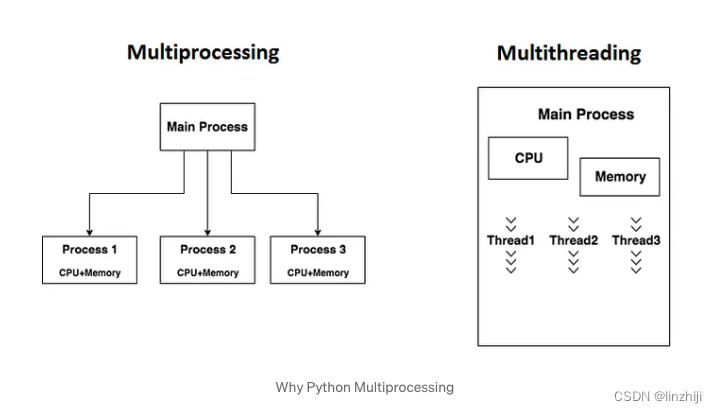
在multiporcessing中,通过新建Process对象创建进程,然后用start()方法调用它。Process与threading.Thread类似。如下是一个简单的例子:
from multiprocessing import Process
def f(name):
print('hello' ,name)
if __name__ == '__main__':
p = Process(target=f, args('bob',))
p.start()
p.join()Queues
from multiprocessing import Process, Queue
def f(q):
q.put([42, None, 'hello'])
if __name__ == '__main__':
q = Queue()
p = Process(target=f, args=(q,))
p.start()
print(q.get()) # prints "[42, None, 'hello']"
p.join()Queues是线程和进程安全的。
Pipes
Pipe可以是单向(half-duplex),也可以是双向(duplex)。我们通过mutiprocessing.Pipe(duplex=False)创建单向管道 (默认为双向)。一个进程从PIPE一端输入对象,然后被PIPE另一端的进程接收,单向管道只允许管道一端的进程输入,而双向管道则允许从两端输入。
import multiprocessing as mul
def proc1(pipe):
pipe.send('hello')
print('proc1 rec:', pipe.recv())
def proc2(pipe):
print('proc2 rec:', pipe.recv())
pipe.send('hello, too')
# Build a pipe
pipe = mul.Pipe()
if __name__ == '__main__':
# Pass an end of the pipe to process 1
p1 = mul.Process(target=proc1, args=(pipe[0],))
# Pass the other end of the pipe to process 2
p2 = mul.Process(target=proc2, args=(pipe[1],))
p1.start()
p2.start()
p1.join()
p2.join()proc2 rec: hello
proc1 rec: hello, tooPipe()函数返回一对用pipe连接在一起的对象,默认情况下是双向的。例如:
from multiprocessing import Process, Pipe
def f(conn):
conn.send([42, None, 'hello'])
conn.close()
if __name__ == '__main__':
parent_conn, child_conn = Pipe()
p = Process(target=f, args=(child_conn,))
p.start()
print(parent_conn.recv()) # prints "[42, None, 'hello']"
p.join()使用Pipe()表示管道的两端,用来连接两个对象。每个连接的对象有send()和recv()方法。注意,如果两个进程(或线程)尝试在同一时间往pipe的一端读取或写入,在pipe中的数据会出现问题。当然,在同一时间使用不同pipe的不同的端就不回出现问题。
参考:
https://www.cnblogs.com/gmhappy/p/11863960.html
https://hiteshmishra708.medium.com/multiprocessing-in-python-c6735fa70f3f